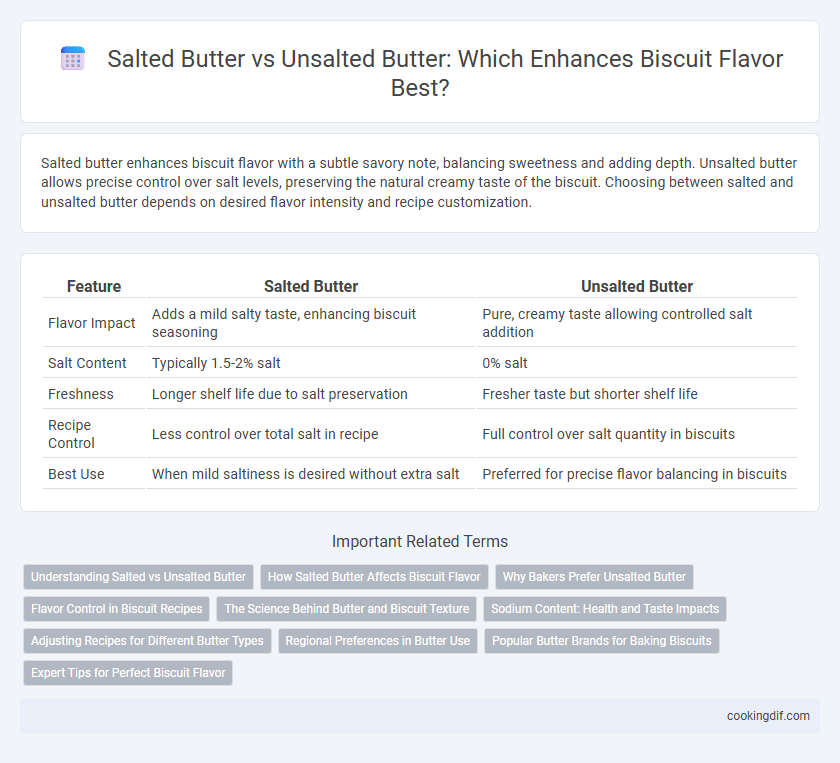Salted butter enhances biscuit flavor with a subtle savory note, balancing sweetness and adding depth. Unsalted butter allows precise control over salt levels, preserving the natural creamy taste of the biscuit. Choosing between salted and unsalted butter depends on desired flavor intensity and recipe customization.
Table of Comparison
| Feature | Salted Butter | Unsalted Butter |
|---|---|---|
| Flavor Impact | Adds a mild salty taste, enhancing biscuit seasoning | Pure, creamy taste allowing controlled salt addition |
| Salt Content | Typically 1.5-2% salt | 0% salt |
| Freshness | Longer shelf life due to salt preservation | Fresher taste but shorter shelf life |
| Recipe Control | Less control over total salt in recipe | Full control over salt quantity in biscuits |
| Best Use | When mild saltiness is desired without extra salt | Preferred for precise flavor balancing in biscuits |
Understanding Salted vs Unsalted Butter
Salted butter contains added salt, which enhances flavor and extends shelf life, making it convenient for general baking but less precise for recipes requiring exact salt control. Unsalted butter offers pure, creamy richness without added salt, allowing bakers to adjust seasoning in biscuits accurately to achieve the desired taste profile. Choosing unsalted butter is often preferred in biscuit recipes to balance sweetness and saltiness perfectly, ensuring consistent flavor and texture.
How Salted Butter Affects Biscuit Flavor
Salted butter enhances biscuit flavor by adding a subtle savory note that balances the sweetness and enriches the overall taste profile. The salt in butter helps to intensify the buttery aroma and can slightly improve the texture by affecting gluten development. Using salted butter in biscuits creates a more complex and satisfying flavor experience compared to unsalted butter.
Why Bakers Prefer Unsalted Butter
Bakers prefer unsalted butter for biscuits because it offers greater control over the final salt content, ensuring a balanced flavor without overpowering the dough. Unsalted butter's fresher taste and consistent quality help maintain the delicate, tender texture essential for flaky biscuits. This precision in seasoning enhances the overall flavor profile, allowing other ingredients to shine.
Flavor Control in Biscuit Recipes
Salted butter contains added salt, which can make it challenging to control the overall salt level in biscuit recipes, potentially overpowering delicate flavors. Unsalted butter provides precise flavor control, allowing bakers to adjust the amount of salt explicitly for a balanced taste. Using unsalted butter ensures consistent results, enhancing the biscuit's natural richness without unintended saltiness.
The Science Behind Butter and Biscuit Texture
Salted butter contains added salt that influences the biscuit's flavor and can tighten gluten strands, resulting in a slightly firmer texture, while unsalted butter allows precise control over salt levels and promotes a tender, flaky crumb. The fat content in both types coats flour proteins, inhibiting excessive gluten formation, which is crucial for achieving the characteristic delicate biscuit texture. Understanding the moisture content and melting point differences in salted versus unsalted butter helps optimize dough consistency and baking performance for the ideal biscuit rise and mouthfeel.
Sodium Content: Health and Taste Impacts
Salted butter contains approximately 90 mg of sodium per tablespoon, which enhances biscuit flavor by adding a subtle savory note and balancing sweetness. Unsalted butter allows precise control over sodium content, making it preferable for those monitoring their salt intake or aiming for a specific taste profile. Choosing unsalted butter supports better health management by reducing overall sodium consumption, while salted butter offers convenience but can lead to higher sodium levels in baked biscuits.
Adjusting Recipes for Different Butter Types
Using salted butter in biscuit recipes adds an unpredictable level of saltiness, often requiring a reduction in additional salt to maintain flavor balance. Unsalted butter provides control over salt content, allowing precise adjustments that enhance the biscuit's natural sweetness and texture. Recipe modifications should consider the moisture content of each butter type, as it affects dough consistency and final biscuit tenderness.
Regional Preferences in Butter Use
Salted butter is favored in regions like the Southern United States for biscuits, imparting a savory and rich flavor that complements traditional recipes. In contrast, Northern and Western areas often prefer unsalted butter to control salt levels and allow more customization of taste. Regional culinary traditions heavily influence these preferences, making salted butter synonymous with classic Southern biscuits while unsalted butter is preferred for standardized baking elsewhere.
Popular Butter Brands for Baking Biscuits
Popular butter brands like Land O'Lakes and Kerrygold offer both salted and unsalted varieties, with unsalted butter preferred by many bakers for precise control over biscuit flavor and salt content. Salted butter, commonly found in brands like Plugra, can enhance the biscuit's taste but may result in inconsistent salt levels depending on the brand's processing. Choosing unsalted butter allows for customization of seasoning, ensuring optimal texture and flavor balance in biscuit recipes.
Expert Tips for Perfect Biscuit Flavor
Salted butter contains added salt that can enhance the biscuit's overall flavor but may make precise seasoning difficult, while unsalted butter offers greater control over salt levels for a balanced taste. Experts recommend using unsalted butter to achieve the perfect biscuit texture and flavor, allowing customization of salt quantity according to recipe requirements. For optimal flavor, chill the butter thoroughly before mixing to create flaky, tender biscuits with a delicate buttery taste.
Salted butter vs Unsalted butter for biscuit flavor Infographic

 cookingdif.com
cookingdif.com